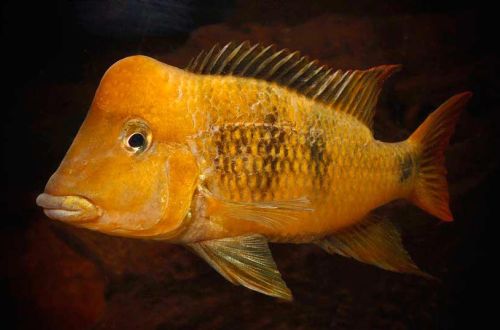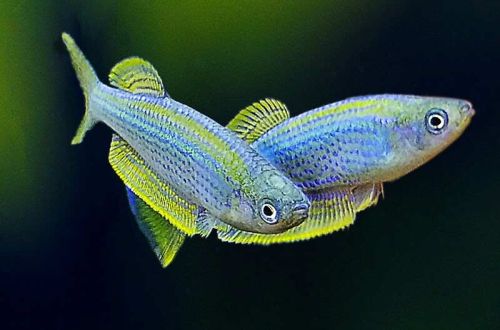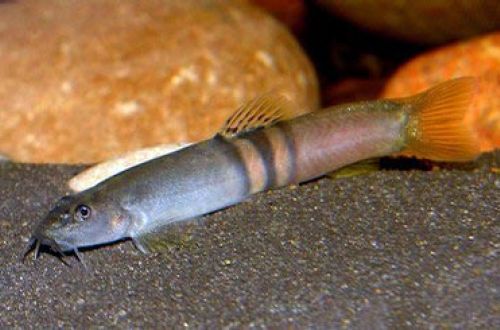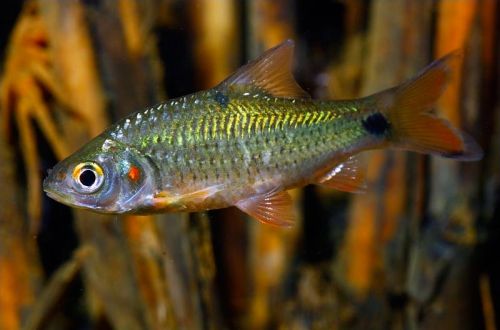
Geophagus Pellegrini
Geophagus Pellegrini or Yellow-humped Geophagus, scientific name Geophagus pellegrini, belongs to the Cichlidae family. The fish is named after the French zoologist Jacques Pellegrini, who first discovered this species. Rarely found in the hobby aquarium, although it would make a great addition to a freshwater aquarium. Considered relatively easy to keep and breed, compatible with many other species.

Contents
Habitat
Comes from South America. Endemic to the San Juan River basin, which flows through the territory of the department of Choco, in northwestern Colombia. Found in various biotopes. The fish was found in small narrow channels with dense aquatic vegetation and silty substrates, as well as in the main riverbed with sandy soil, numerous snags and the absence of aquatic plants.
Brief information:
- The volume of the aquarium – from 250 liters.
- Temperature – 25-30°C
- Value pH — 5.0–6.0
- Water hardness – 0–5 dGH
- Substrate type – sandy
- Lighting – subdued
- Brackish water – no
- Water movement is weak
- The size of the fish is 13–15 cm.
- Food – any sinking food
- Temperament – peaceful
- Content in a group of at least 5–8 individuals
Description

Adults reach a length of 13–15 cm. Unlike females, males are somewhat larger than females and have pointed dorsal and anal fin tips (elongated last rays). In addition, the occipital hump appears on the head. In alpha males, it becomes quite large. The coloration is orange or yellow with rows of dark strokes on the body.
Food
It feeds near the bottom by sifting portions of the soil with its mouth in search of small invertebrates. This way of feeding implies the presence of sandy soil in the aquarium. Accepts most popular sinking foods, such as dry flakes, pellets combined with frozen brine shrimp, daphnia, bloodworm pieces.
Maintenance and care, arrangement of the aquarium
The optimal aquarium size for a group of 5-8 fish starts at 250 liters. Geophagus Pellegrini looks most natural in an environment reminiscent of one of his natural biotopes. For example, in dim lighting conditions among snags and scattered large boulders / stones. The most important design element is the substrate. It is necessary to use soft sandy soil so that the fish can eat normally (more on this above).
Long-term maintenance requires maintaining high water quality. Sharp fluctuations in temperature and hydrochemical composition of water, as well as the accumulation of dangerous concentrations of nitrogen cycle products (ammonia, nitrites, nitrates) should not be allowed. For this purpose, a productive filtration system is installed and regular maintenance of the aquarium is carried out. The latter includes procedures such as weekly replacement of part of the water with fresh water, cleaning the soil from organic waste, equipment maintenance, etc.
Behavior and Compatibility
During spawning periods, fish actively protect their offspring and can become uncomfortable neighbors. This situation is most relevant for small aquariums. Otherwise peaceful calm fish, able to get along with other non-aggressive freshwater species.
Intraspecific relationships are built on the dominance of the alpha male. At the same time, weaker individuals do not experience any attacks on their part. It is recommended to keep a group of 5-8 individuals of both sexes.
Breeding / breeding
In favorable conditions, the probability of the appearance of fry is quite high. The dominant male chooses a female for himself, forming a temporary pair with her, which, however, can persist for a long period. The couple occupies a plot at the bottom of the aquarium where spawning will take place. The female lays several dozen eggs on a flat surface and, after fertilization, takes them into her mouth. In this “shelter” the eggs are throughout the entire incubation period (several days). The fry that have appeared continue to be in the mouth. The female occasionally releases a brood for feeding. Each time, the time intervals increase and in the end the fry begin to swim freely. All this time, the male guards the female with the brood from any potential danger.
Fish diseases
The main cause of diseases lies in the conditions of detention, if they go beyond the permissible range, then immunity suppression inevitably occurs and the fish becomes susceptible to various infections that are inevitably present in the environment. If the first suspicions arise that the fish is sick, the first step is to check the water parameters and the presence of dangerous concentrations of nitrogen cycle products. Restoration of normal/suitable conditions often promotes healing. However, in some cases, medical treatment is indispensable. Read more about symptoms and treatments in the Aquarium Fish Diseases section.





